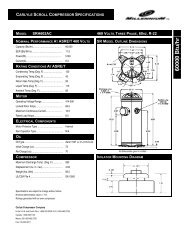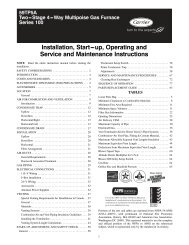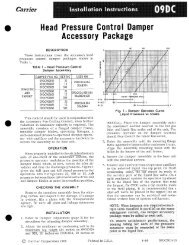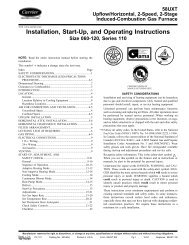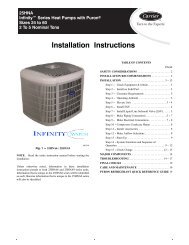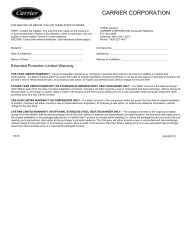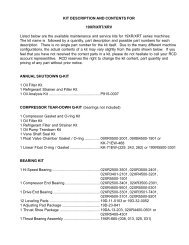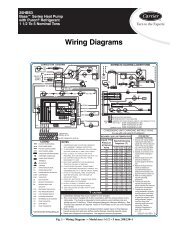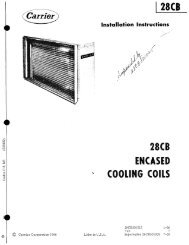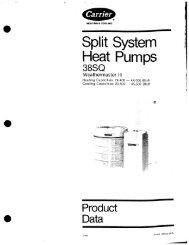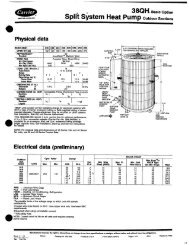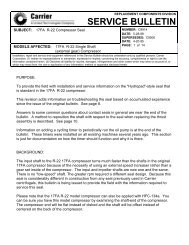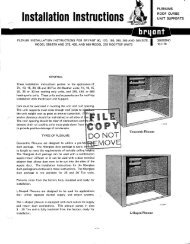Controls, Start-Up, Operation, Service And Troubleshooting - Carrier
Controls, Start-Up, Operation, Service And Troubleshooting - Carrier
Controls, Start-Up, Operation, Service And Troubleshooting - Carrier
- No tags were found...
Create successful ePaper yourself
Turn your PDF publications into a flip-book with our unique Google optimized e-Paper software.
CONTENTS (cont)Page• COOLER LEAVING FLUID SENSOR• COOLER ENTERING FLUID SENSOR• DUAL CHILLER LWT• COMPRESSOR RETURN GAS TEMPERATURE• OUTDOOR AIR TEMPERATURE• REMOTE SPACE TEMPERATURE<strong>Service</strong> Test. . . . . . . . . . . . . . . . . . . . . . . . . . . . . . . . . . . . . . . . 74APPENDIX A — LOCAL DISPLAY TABLES . . . . . . 81-92APPENDIX B — CCN TABLES . . . . . . . . . . . . . . . . . . 93-106APPENDIX C — CCN ALARM DESCRIPTION . . 107-110APPENDIX D — R-410A PRESSURE VS.TEMPERATURE CHART. . . . . . . . . . . . . . . . . . . . . . . . . 111INDEX. . . . . . . . . . . . . . . . . . . . . . . . . . . . . . . . . . . . . . . . . .112,113START-UP CHECKLIST FOR 30RBLIQUID CHILLER . . . . . . . . . . . . . . . . . . . . . . . . CL-1 to CL-9SAFETY CONSIDERATIONSInstalling, starting up, and servicing this equipment can behazardous due to system pressures, electrical components, andequipment location (roof, elevated structures, etc.). Onlytrained, qualified installers and service mechanics shouldinstall, start up, and service this equipment. When working onthis equipment, observe precautions in the literature, and ontags, stickers, and labels attached to the equipment, and anyother safety precautions that apply. Follow all safety codes.Wear safety glasses and work gloves. Use care in handling,rigging, and setting this equipment, and in handling all electricalcomponents.Electrical shock can cause personal injury and death. Shutoff all power to this equipment during installation and service.There may be more than one disconnect switch. Tagall disconnect locations to alert others not to restore poweruntil work is completed.This unit uses a microprocessor-based electronic controlsystem. Do not use jumpers or other tools to short out components,or to bypass or otherwise depart from recommendedprocedures. Any short-to-ground of the controlboard or accompanying wiring may destroy the electronicmodules or electrical components.To prevent potential damage to heat exchanger tubes,always run fluid through heat exchanger when adding orremoving refrigerant charge. Use appropriate anti-freezesolutions in cooler fluid loop to prevent the freezing of heatexchanger, optional hydronic section and/or interconnectingpiping when the equipment is exposed to temperaturesbelow 32 F (0 °C). Proof of flow switch and strainer (whenhydronic kit is supplied) are factory installed on all models.Do NOT remove power from this chiller during winter shutdown periods without taking precaution to remove allwater from heat exchanger and optional hydronic system.Failure to properly protect the system from freezing mayconstitute abuse and may void warranty.Compressors and optional hydronic system pumps requirespecific rotation. Test condenser fan(s) first to ensureproper phasing. Swap any two incoming power leads tocorrect condenser fan rotation before starting any othermotors. Operating the unit without testing the condenserfan(s) for proper phasing could result in equipmentdamage.Refrigerant charge must be removed slowly to prevent lossof compressor oil that could result in compressor failure.DO NOT VENT refrigerant relief valves within a building.Outlet from relief valves must be vented in accordancewith the latest edition of ANSI/ASHRAE (AmericanNational Standards Institute/American Society of Heating,Refrigeration and Air Conditioning Engineers) 15 (SafetyCode for Mechanical Refrigeration). The accumulation ofrefrigerant in an enclosed space can displace oxygen andcause asphyxiation. Provide adequate ventilation inenclosed or low overhead areas. Inhalation of high concentrationsof vapor is harmful and may cause heart irregularities,unconsciousness or death. Misuse can be fatal. Vaporis heavier than air and reduces the amount of oxygen availablefor breathing. Product causes eye and skin irritation.Decomposition products are hazardous.DO NOT attempt to unbraze factory joints when servicingthis equipment. Compressor oil is flammable and there isno way to detect how much oil may be in any of the refrigerantlines. Cut lines with a tubing cutter as required whenperforming service. Use a pan to catch any oil that maycome out of the lines and as a gage for how much oil to addto system. DO NOT re-use compressor oil.This system uses Puron® refrigerant which has higherpressures than R-22 and other refrigerants. No other refrigerantcan be used in this system. Failure to use gage set,hoses, and recovery system designed to handle Puronrefrigerant may result in personal injury. If you are unsure,consult the equipment manufacturer.GENERALThis publication contains <strong>Controls</strong>, <strong>Operation</strong>, <strong>Start</strong>-<strong>Up</strong>,<strong>Service</strong> and <strong>Troubleshooting</strong> information for the 30RB060-390air-cooled liquid chillers with electronic controls. The 30RBchillers are equipped with ComfortLink controls andelectronic expansion valves.NOTE: Unit sizes 315-390 are modular units that are shippedin separate sections as modules A or B as noted in position 8 ofthe unit model number. Installation directions specific to theseunits are noted in these instructions. For modules 315A, 315B,330A, 330B, 345A, 345B, and 360B, follow all generalinstructions as noted for unit sizes 30RB160,170. For modules,360A, 390A, and 390B follow instructions for 30RB190. SeeTable 1 for a listing of unit sizes and modular combinations.NOTE: The nameplate for modular units contains only the firsttwo digits in the model number. For example, 315A and 315Bnameplates read 31A and 31B.2



